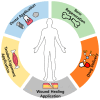Biomineral-Based Composite Materials in Regenerative Medicine
- PMID: 38892335
- PMCID: PMC11173312
- DOI: 10.3390/ijms25116147
Biomineral-Based Composite Materials in Regenerative Medicine
Abstract
Regenerative medicine aims to address substantial defects by amplifying the body's natural regenerative abilities and preserving the health of tissues and organs. To achieve these goals, materials that can provide the spatial and biological support for cell proliferation and differentiation, as well as the micro-environment essential for the intended tissue, are needed. Scaffolds such as polymers and metallic materials provide three-dimensional structures for cells to attach to and grow in defects. These materials have limitations in terms of mechanical properties or biocompatibility. In contrast, biominerals are formed by living organisms through biomineralization, which also includes minerals created by replicating this process. Incorporating biominerals into conventional materials allows for enhanced strength, durability, and biocompatibility. Specifically, biominerals can improve the bond between the implant and tissue by mimicking the micro-environment. This enhances cell differentiation and tissue regeneration. Furthermore, biomineral composites have wound healing and antimicrobial properties, which can aid in wound repair. Additionally, biominerals can be engineered as drug carriers, which can efficiently deliver drugs to their intended targets, minimizing side effects and increasing therapeutic efficacy. This article examines the role of biominerals and their composite materials in regenerative medicine applications and discusses their properties, synthesis methods, and potential uses.
Keywords: biomineral; biomineral composites; hard tissue engineering; regenerative medicine.
Conflict of interest statement
The authors declare no conflicts of interest.
Figures









Similar articles
-
Application of metal-organic framework materials in regenerative medicine.J Mater Chem B. 2024 Sep 11;12(35):8543-8576. doi: 10.1039/d4tb00226a. J Mater Chem B. 2024. PMID: 39136436 Review.
-
Recent insights on applications of pullulan in tissue engineering.Carbohydr Polym. 2016 Nov 20;153:455-462. doi: 10.1016/j.carbpol.2016.07.118. Epub 2016 Aug 1. Carbohydr Polym. 2016. PMID: 27561517 Review.
-
Biocomposites reinforced by fibers or tubes as scaffolds for tissue engineering or regenerative medicine.J Biomed Mater Res A. 2014 May;102(5):1580-94. doi: 10.1002/jbm.a.34801. Epub 2013 Jun 7. J Biomed Mater Res A. 2014. PMID: 23681610 Review.
-
Recent Advances in Biopolymeric Composite Materials for Tissue Engineering and Regenerative Medicines: A Review.Molecules. 2021 Jan 25;26(3):619. doi: 10.3390/molecules26030619. Molecules. 2021. PMID: 33504080 Free PMC article. Review.
-
A natural biomineral for enhancing the biomineralization and cell response of 3D printed polylactic acid bone scaffolds.Int J Biol Macromol. 2023 Jul 1;242(Pt 1):124728. doi: 10.1016/j.ijbiomac.2023.124728. Epub 2023 May 5. Int J Biol Macromol. 2023. PMID: 37150372
Cited by
-
Machine Learning in Predicting and Optimizing Polymer Printability for 3D Bioprinting.Polymers (Basel). 2025 Jul 4;17(13):1873. doi: 10.3390/polym17131873. Polymers (Basel). 2025. PMID: 40647883 Free PMC article. Review.
-
Special Issue: "Application of Nanotechnology in Regenerative Medicine".Int J Mol Sci. 2025 Jul 2;26(13):6393. doi: 10.3390/ijms26136393. Int J Mol Sci. 2025. PMID: 40650171 Free PMC article.
-
Biochar Utilization in Antimicrobial, Anticancer, and Biosensing Applications: A Review.Biomolecules. 2025 May 25;15(6):760. doi: 10.3390/biom15060760. Biomolecules. 2025. PMID: 40563402 Free PMC article. Review.
-
Investigation of Calcium Phosphate-Based Biopolymer Composite Scaffolds for Bone Tissue Engineering.Int J Mol Sci. 2024 Dec 22;25(24):13716. doi: 10.3390/ijms252413716. Int J Mol Sci. 2024. PMID: 39769477 Free PMC article.
-
Multimodal Synergistic Strategies for Diabetic Wound Healing Using Glucose Oxidase Nanocomposites: Therapeutic Mechanisms and Nanomaterial Design.Int J Nanomedicine. 2025 May 2;20:5727-5762. doi: 10.2147/IJN.S515057. eCollection 2025. Int J Nanomedicine. 2025. PMID: 40337147 Free PMC article.
References
-
- Mohaghegh N., Endo-Kimura M., Wang K., Wei Z., Hassani Najafabadi A., Zehtabi F., Hosseinzadeh Kouchehbaghi N., Sharma S., Markowska-Szczupak A., Kowalska E. Apatite-coated Ag/AgBr/TiO2 nanocomposites: Insights into the antimicrobial mechanism in the dark and under visible-light irradiation. Appl. Surf. Sci. 2023;617:156574. doi: 10.1016/j.apsusc.2023.156574. - DOI
Publication types
MeSH terms
Substances
Grants and funding
LinkOut - more resources
Full Text Sources

